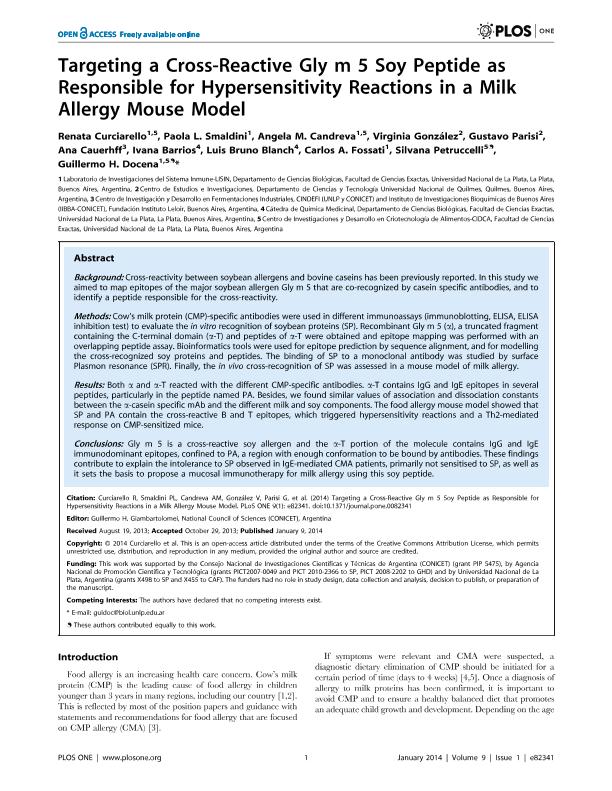Artículo
Targeting a cross-reactive Gly m 5 soy peptide as responsible for hypersensitivity reactions in a milk allergy mouse model
Curciarello, Renata ; Smaldini, Paola Lorena
; Smaldini, Paola Lorena ; Candreva, Ángela María
; Candreva, Ángela María ; González, Virginia; Parisi, Gustavo Daniel
; González, Virginia; Parisi, Gustavo Daniel ; Cauerff, Ana Albina
; Cauerff, Ana Albina ; Barrios, Ivana Analia
; Barrios, Ivana Analia ; Bruno Blanch, Luis Enrique; Fossati, Carlos Alberto
; Bruno Blanch, Luis Enrique; Fossati, Carlos Alberto ; Petruccelli, Silvana
; Petruccelli, Silvana ; Docena, Guillermo H.
; Docena, Guillermo H.
 ; Smaldini, Paola Lorena
; Smaldini, Paola Lorena ; Candreva, Ángela María
; Candreva, Ángela María ; González, Virginia; Parisi, Gustavo Daniel
; González, Virginia; Parisi, Gustavo Daniel ; Cauerff, Ana Albina
; Cauerff, Ana Albina ; Barrios, Ivana Analia
; Barrios, Ivana Analia ; Bruno Blanch, Luis Enrique; Fossati, Carlos Alberto
; Bruno Blanch, Luis Enrique; Fossati, Carlos Alberto ; Petruccelli, Silvana
; Petruccelli, Silvana ; Docena, Guillermo H.
; Docena, Guillermo H.
Fecha de publicación:
01/2014
Editorial:
Public Library of Science
Revista:
Plos One
ISSN:
1932-6203
Idioma:
Inglés
Tipo de recurso:
Artículo publicado
Clasificación temática:
Resumen
Background: Cross-reactivity between soybean allergens and bovine caseins has been previously reported. In this study we aimed to map epitopes of the major soybean allergen Gly m 5 that are co-recognized by casein specific antibodies, and to identify a peptide responsible for the cross-reactivity. Methods Cow´s milk protein (CMP)-specific antibodies were used in different immunoassays (immunoblotting, ELISA, ELISA inhibition test) to evaluate the in vitro recognition of soybean proteins (SP). Recombinant Gly m 5 (α), a truncated fragment containing the C-terminal domain (α-T) and peptides of α-T were obtained and epitope mapping was performed with an overlapping peptide assay. Bioinformatics tools were used for epitope prediction by sequence alignment, and for modelling the cross-recognized soy proteins and peptides. The binding of SP to a monoclonal antibody was studied by surface Plasmon resonance (SPR). Finally, the in vivo cross-recognition of SP was assessed in a mouse model of milk allergy. Results Both α and α-T reacted with the different CMP-specific antibodies. α-T contains IgG and IgE epitopes in several peptides, particularly in the peptide named PA. Besides, we found similar values of association and dissociation constants between the α-casein specific mAb and the different milk and soy components. The food allergy mouse model showed that SP and PA contain the cross-reactive B and T epitopes, which triggered hypersensitivity reactions and a Th2-mediated response on CMP-sensitized mice. Conclusions Gly m 5 is a cross-reactive soy allergen and the α-T portion of the molecule contains IgG and IgE immunodominant epitopes, confined to PA, a region with enough conformation to be bound by antibodies. These findings contribute to explain the intolerance to SP observed in IgE-mediated CMA patients, primarily not sensitised to SP, as well as it sets the basis to propose a mucosal immunotherapy for milk allergy using this soy peptide.
Archivos asociados
Licencia
Identificadores
Colecciones
Articulos(CIDCA)
Articulos de CENTRO DE INV EN CRIOTECNOLOGIA DE ALIMENTOS (I)
Articulos de CENTRO DE INV EN CRIOTECNOLOGIA DE ALIMENTOS (I)
Articulos(CINDEFI)
Articulos de CENT.DE INV EN FERMENTACIONES INDUSTRIALES (I)
Articulos de CENT.DE INV EN FERMENTACIONES INDUSTRIALES (I)
Citación
Curciarello, Renata; Smaldini, Paola Lorena; Candreva, Ángela María; González, Virginia; Parisi, Gustavo Daniel; et al.; Targeting a cross-reactive Gly m 5 soy peptide as responsible for hypersensitivity reactions in a milk allergy mouse model; Public Library of Science; Plos One; 9; 1; 1-2014; 1-15
Compartir
Altmétricas



